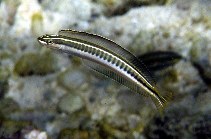| Family: |
Blenniidae (Combtooth blennies), subfamily: Blenniinae |
| Max. size: |
14 cm TL (male/unsexed) |
| Environment: |
reef-associated; marine; depth range 0 - 45 m |
| Distribution: |
Indo-Pacific: Red Sea and East Africa (to False Bay, South Africa, Ref. 4404) to the Line, Marquesan, and Tuamoto Islands, north to southern Japan, south to New Zealand and Rapa. Replaced Plagiotremus goslinei in the Hawaiian Islands (Ref. 37816). |
| Diagnosis: |
Dorsal spines (total): 7-9; Dorsal soft rays (total): 34-39; Anal spines: 2-2; Anal soft rays: 28-33. About 20 oblong segments form the dark midlateral body stripe (Ref. 4404). |
| Biology: |
Adults inhabit clear lagoon and seaward reefs (Ref. 9710), usually the lower surge zone to deeper areas. They hide in deserted worm tubes when alarmed (Ref. 1602). They feed by attacking other fishes and removing dermal tissue, mucus and sometimes scales; occasionally makes harmless 'attacks' on divers (Ref. 2334, 48636). Some individuals usually strike from behind and quickly dive in the reef for cover to avoid punishment (Ref. 48636). Their wriggling swimming mode possibly mimics other non-scale eating species. Oviparous. Eggs are demersal and adhesive (Ref. 205), and are attached to the substrate via a filamentous, adhesive pad or pedestal (Ref. 94114). Larvae are planktonic, often found in shallow, coastal waters (Ref. 94114). Minimum depth reported taken from Ref. 128797. |
| IUCN Red List Status: |
Least Concern (LC); Date assessed: 29 March 2009 Ref. (130435)
|
| Threat to humans: |
other |
| Country info: |
|
Source and more info: www.fishbase.org. For personal, classroom, and other internal use only. Not for publication.

